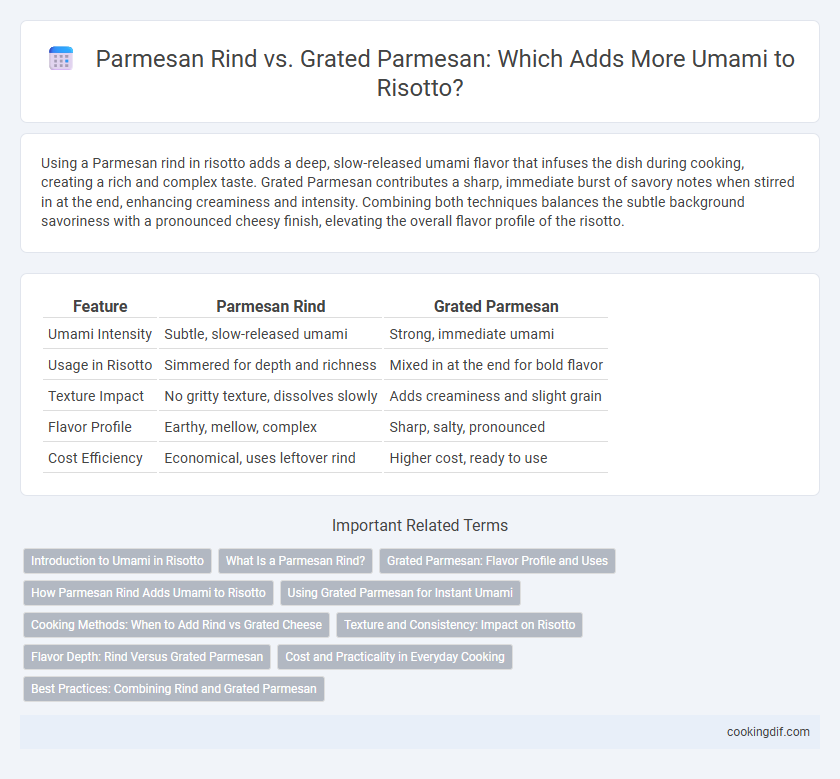Using a Parmesan rind in risotto adds a deep, slow-released umami flavor that infuses the dish during cooking, creating a rich and complex taste. Grated Parmesan contributes a sharp, immediate burst of savory notes when stirred in at the end, enhancing creaminess and intensity. Combining both techniques balances the subtle background savoriness with a pronounced cheesy finish, elevating the overall flavor profile of the risotto.
Table of Comparison
| Feature | Parmesan Rind | Grated Parmesan |
|---|---|---|
| Umami Intensity | Subtle, slow-released umami | Strong, immediate umami |
| Usage in Risotto | Simmered for depth and richness | Mixed in at the end for bold flavor |
| Texture Impact | No gritty texture, dissolves slowly | Adds creaminess and slight grain |
| Flavor Profile | Earthy, mellow, complex | Sharp, salty, pronounced |
| Cost Efficiency | Economical, uses leftover rind | Higher cost, ready to use |
Introduction to Umami in Risotto
Parmesan rind releases a slow, deep umami richness when simmered in risotto, enhancing the broth with natural glutamates and peptides that intensify savory flavors. Grated Parmesan, added at the end, provides an immediate burst of sharp, creamy umami that complements the texture and melds with the rice. Incorporating both rind and grated cheese layers umami complexity, creating a balanced and deeply flavorful risotto experience.
What Is a Parmesan Rind?
A Parmesan rind is the hard outer edge of a Parmigiano-Reggiano cheese wheel, rich in concentrated umami compounds that slowly infuse dishes like risotto during cooking. Unlike grated Parmesan, which adds immediate cheesy flavor and texture, the rind dissolves over time, deepening the savory profile without altering the risotto's texture. Using a Parmesan rind enhances umami complexity and richness, elevating the overall depth of flavor in creamy risotto recipes.
Grated Parmesan: Flavor Profile and Uses
Grated Parmesan delivers a concentrated umami boost and a nutty, savory flavor that enhances risotto's richness. Its fine texture allows for quick melting, creating a creamy consistency and perfectly binding the rice grains. Commonly stirred in during the final cooking stage, grated Parmesan intensifies both aroma and taste, making it essential for authentic Italian risotto recipes.
How Parmesan Rind Adds Umami to Risotto
Parmesan rind infuses risotto with a deep, savory umami flavor as it slowly releases glutamates during cooking, enriching the broth and enhancing the overall taste complexity. Unlike grated Parmesan, which primarily adds surface seasoning, the rind imparts a subtle, layered richness that intensifies the creamy texture and savory notes of the dish. Incorporating Parmesan rind allows for sustained flavor infusion, resulting in a more aromatic and satisfying risotto experience.
Using Grated Parmesan for Instant Umami
Using grated Parmesan in risotto delivers immediate umami flavor, as its fine texture allows rapid melting and even distribution throughout the dish. Grated Parmesan infuses the creamy risotto with rich, savory notes instantly, unlike Parmesan rind, which releases umami slowly and requires longer cooking time to extract. For a quick and evenly seasoned risotto, grated Parmesan is the optimal choice to enhance depth and complexity.
Cooking Methods: When to Add Rind vs Grated Cheese
Adding Parmesan rind during the simmering phase of risotto infuses a deep umami richness as it slowly releases flavor into the broth. Grated Parmesan should be stirred in at the end of cooking to melt smoothly and enhance creaminess without overpowering the dish. This method balances the robust, savory notes from the rind with the fresh, sharp finish from the grated cheese for optimal taste.
Texture and Consistency: Impact on Risotto
Parmesan rind melts slowly in risotto, enhancing the broth's umami depth without altering texture, creating a smooth and creamy consistency. Grated Parmesan disperses evenly, thickening the risotto and adding a slightly granular texture that intensifies flavor on each bite. Using rind contributes to a silkier mouthfeel, while grated cheese provides a richer, denser finish, influencing the overall balance of creaminess and body in the dish.
Flavor Depth: Rind Versus Grated Parmesan
Parmesan rind imparts a deeper, more complex umami flavor to risotto by slowly releasing concentrated savory compounds during simmering, enriching the broth with subtle nutty and earthy notes. In contrast, grated Parmesan offers immediate, sharp, and creamy umami intensity that integrates quickly but dissipates faster in the dish. Using rind for extended cooking elevates flavor depth, while grated cheese enhances finishing texture and fresh taste.
Cost and Practicality in Everyday Cooking
Using Parmesan rind in risotto offers a cost-effective way to infuse deep umami flavor as it slowly releases savory compounds during cooking, reducing waste and extending ingredient value. Grated Parmesan, while delivering immediate intense taste and creamy texture, is more expensive per serving and less practical for simmering long periods without clumping. Incorporating rinds maximizes flavor extraction in budget-conscious, practical cooking routines, whereas grated cheese excels as a finishing touch for richness.
Best Practices: Combining Rind and Grated Parmesan
Combining Parmesan rind and grated Parmesan enhances risotto's umami depth by utilizing the rind's slow, infused flavor release during cooking and the grated cheese's immediate, creamy richness. Adding rind early in the broth or during simmering extracts glutamates that build savory complexity, while grated Parmesan folded in at the end maximizes texture and aroma. This best practice balances sustained umami infusion with fresh cheese intensity, elevating risotto's taste profile.
Parmesan rind vs grated Parmesan for umami Infographic

 cookingdif.com
cookingdif.com